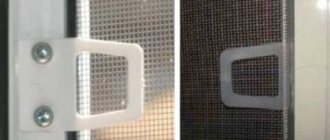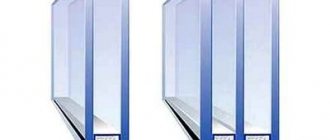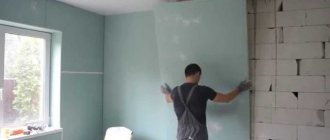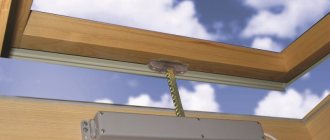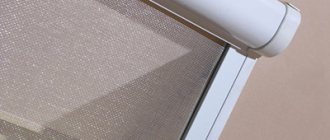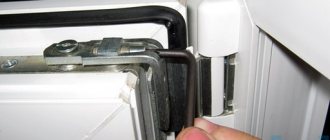Automation for windows helps to minimize human participation in the process of opening and closing sashes or transoms. Today it is used not only to facilitate the opening of heavy and hard-to-reach structures. Such systems are excellent for creating the most comfortable conditions - remote ventilation of rooms, automatic regulation of humidity levels and overcoming wind or snow loads. Since remote control of a window can be carried out in different ways, in this article we will tell you how to choose the right automatic systems for opening sashes.
How window automation works
Automation for windows made of PVC, wooden and aluminum profiles consists of an electric drive and a control system. Depending on the modification and method of installation of windows, these devices are mounted on frames, slopes, walls, roofing or window sills. All of them must be connected to active sashes and transoms. When voltage is applied to the electric motor, the drive pushes the sash through a transmission mechanism using a rod. When the device is turned on in reverse mode, the rod along with the sash is retracted back and the window closes.
Drives may push and retract a rigid moving element differently in different ways, have different dimensions and power, but their basic principle of operation is always the same. It is based on converting the rotation of an electric motor into the linear movement of the drive element, which opens and closes the window.
Correct transoms in the fire protection system.
The transom control system consists of:
- Transom drive.
- Transom control device.
The control device for the transom drive must comply with the requirements for fire control devices, namely:
- Monitor the control circuit for open circuit and short circuit.
- Control extreme positions.
- Have remote control input signals.
- Have dispatching outputs.
- Have controls and indications on the instrument panel.
- Have an alarm and accident buzzer.
Ways to control window automation
In order for the drive to open or close the window, voltage must be applied to the electric motor at the right time.
This operation can be performed in different ways. The function of supplying operating voltage is always performed by a special actuator. In the simplest and most affordable option, manual switches are used for this purpose. When choosing this opening method, electronic boards are not required, since the person personally sends and interrupts the pulses. In all other situations, more complex systems are used. They are actuators that are controlled from a central panel or remote control. Signals are transmitted through wired communications or radio waves. A different number of windows can be connected to such devices. The number of valves controlled from one block depends on the modification. Thanks to the use of the executive unit and the central panel, you can expand your capabilities:
- open windows at the appointed time without personal participation;
- automatically close the doors during rain, heat or strong wind;
- ventilate rooms when the temperature or humidity level in the premises increases;
- control windows from anywhere in the world using a smartphone, laptop or computer.
The number of functions depends on the choice of the type of receiving and control unit. Some boards that provide signals to the motor are compatible with humidity, temperature and wind sensors. Other devices are fully controlled through a central panel integrated into the Smart Home system. The cost of receiving and control units is 5,000-60,000 rubles per unit, and the price and functionality of the control device are determined by its type.
PM switches
This is the most affordable and simple device, which is a regular switch connected via wires to the main device. Depending on the model, the device key is fixed in 2 or 3 positions (up/down/middle), which allows you to send signals to the drive to open and close the sash. The range of these devices is supplemented by models with several keys designed for connection to a group of electric motors. The cost of these devices ranges from 400 to 4000 rubles.
| Advantages | Flaws |
| Possibility to control several doors from one place | Minimum number of functions |
| Easy to use | Having to walk to windows to open them or run wires across the room to where the switch is installed |
| Reliability |
Remote controls
Without an actuator, it will not be possible to open and close the window using this method. The remote control does not send commands directly to the drive, but to the electronic board to which the motors are connected. This control method is much more convenient than opening and closing windows using manual switches. Remote controls cost from 1000 to 4000 rubles.
| Advantages | Flaws | |
| No need to go close to windows to open and close them | Window remote controls have the same problems as similar devices for controlling other household appliances - they are often lost in the house and broken due to carelessness | |
| It is possible to control several sashes individually or groups of windows | If the executive unit is controlled exclusively by the remote control, it cannot be given a command from a smartphone or computer | |
| There is a function for programming the actions of the controller, which will give a command to open the sashes independently at a certain temperature, humidity and weather outside the window | ||
Control via central panel
Currently, this is the most advanced and convenient device for controlling shutters. It can be installed separately only for windows in the form of a wireless wall-mounted keyboard or integrated into the overall Smart Home system. As in the case of remote control panels, these controllers send commands to actuators, which transmit signals to the drives. Such devices cost from 5,000 to 40,000 rubles.
| Advantages | Flaws | |
| The ability to control the opening of windows while outside your home, office or business | Unified are controlled by software that may fail | |
| Compatible with automatic blinds and window shutters | Wireless systems are susceptible to interference | |
| Individual programming of windows to open and close independently when rain, sun, wind, and temperature sensors are triggered | When choosing a wired control system, you must take care in advance of laying numerous wires | |
To increase the number of controlled drives, special synchronizers and expansion modules are used. They cost from 5,500 to 30,000 rubles.
Transom drive "Giesse VARIA UNI 230V".
It happens that even for smoke removal systems any available drives are used. Even if transom drives are used as part of systems intended for smoke removal, it is still possible that control cabinets for these drives are not available due to their high price or inadequate delivery times. Spin as you please.
They are usually unscrewed using conventional relay blocks of the “UK-VK” or “S2000-SP1” type.
But now the task of automating transoms within the medical gas (oxygen supply) system based on Bolid equipment is being considered: the transoms must open when the oxygen level is exceeded.
This is not a fire protection system (FPS) or even a fire automatic system (SPA).
But formally it is necessary to control the integrity of the transom opening circuit and ensure the receipt of a signal that the transom is open. Simply put, in standby mode the green “Ready” LED should be lit, which signals that the system will operate if necessary. Indeed, an excess of oxygen is a rather dangerous situation and an uncontrolled break or malfunction of the automatic transom opening is unacceptable.
Such experiments on large objects are hardly justified - since someone has decided to use any transom drives - they are automated anyway: using relay control modules "S2000-SP2" or "S2000-SP1".
But this object contributed to the normal approach of doing everything as best as possible.
True, the “best solution” was not suitable, since the best thing was to use a special “CV10” control unit from the manufacturer.
By the way, there is also a block for the smoke control system “CF10/2” in the range.
I was surprised to discover that the remote start of these units requires a normally open contact, which raises the problem of monitoring the integrity of the control line when using these units for a smoke removal system.
But the control units given as an example are designed for 24V transom drives controlled by polarity reversal. I don’t know what I would do if there were drives with 24V alternating control, but I came across drives with 220V reversible control “Giesse Varia UNI 220”.
The standard control unit for such drives “M2134” was just an ordinary relay at an inadequate price, so it was decided to control the transom drives using the valve control unit “S2000-SP4”.
Scope of window automation
It is rational not to deal with problems that arise during the operation of the windows, but to prevent them in advance. To do this, you will need to supplement the list of components with auxiliary devices at the ordering stage. Here is a list of the most common situations when you may need to open windows automatically:
- The shutters or transoms are located in hard-to-reach areas - this situation usually arises when using roof windows, skylights, upper glazing areas of winter gardens and greenhouses. Also relevant for standard structures that are installed in openings that are too high.
- Active shutters have too much weight or size - this mainly happens when using panoramic glazing and installing windows in large openings. When at least one member of the family or work team experiences difficulty opening the sashes for this reason, you need to install a window drive.
- There is a noticeable snow load on the structure - such problems most often arise during the operation of roof windows and skylights. In these cases, automation is needed not only for ventilation, but also to ensure safety. If there are autonomous ventilation systems in the room, it should be taken into account that opening the doors may also be necessary in the event of a fire. As a result, in such situations, electric windows are a must.
- Window owners have to deal with high wind loads - this is important for the upper floors of high-rise buildings and areas with difficult climatic conditions. In such cases, electric drives help not only to open windows, but also help maintain their integrity. After all, they additionally limit the reverse movement of the valves.
- People with disabilities are expected to be present in areas where new windows are used - this applies to both residential and work premises. By modern standards, automatic opening of windows is mandatory in this case.
Also, regardless of the type, dimensions, weight and installation location of window structures, when they are connected to individual sensors or a centralized Smart Home system, integration of electric drives will automatically be required.
Window automation is in demand when operating not only standard structures made on the basis of traditional profiles made of PVC, wood or aluminum. It is also necessary for completing facade glazing systems.
Basic principles of operation of the smoke removal and automatic ventilation system
Any modern smoke and heat removal system is based on the integrated use of control sensors and drives for automatic opening of the valves. For effective air circulation, it must be supplemented with fresh air ventilation devices. In this case, fresh air will enter the building and displace smoke and other combustion products through open windows.
If heat removal and smoke removal systems are not equipped with fans, their efficiency will be significantly reduced. After all, without a forced air flow, combustion products will accumulate in rooms even with open windows and hatches. Only part of the smoke and heat will escape from the premises naturally. This is not enough to ensure the safety of people in the building.
With proper design of smoke removal during a fire, air enters from the side of possible emergency exits. That is, people on the way to salvation get the opportunity to breathe fresh street air. This significantly increases their chances of leaving the building. After all, at unequipped facilities, many victims are found precisely on the way to emergency exits. They do not have time to reach them due to the increased concentration of carbon dioxide. A stream of clean air reduces the likelihood of loss of consciousness and possible death.
Opening windows or hatches and turning on fresh ventilation occurs after the controllers, which are connected to sensors, are activated. Safe smoke removal in case of fire operates according to the following algorithm:
- Sensors detect combustion products or record an increase in temperature and transmit a signal to the controller.
- The receiving and control device processes the received information and issues commands to turn on the drives and fans.
- The drives open hatches or window sashes through which combustion products pushed out by incoming fresh air exit the premises.
This is enough to help people quickly leave the building and make it easier for firefighters to extinguish the fire. The systems also allow you to ventilate rooms automatically. They can be equipped with rain, wind, sun sensors and with their help create a perfect ventilation system.
Types of drives for windows
Any drive for opening windows consists of a housing, an electric motor, an ejection and retraction mechanism, and a fastening system. These are common elements for all products. However, they differ from each other in the method of converting movement, power and stroke length of the rod element. Currently there are 4 types of these devices. Their performance is determined by the force of pushing and retracting. The larger this parameter, the heavier the leaf that the drive can open.
Spindle (rod) drives
Spindle automatic opening systems operate on the principle of a screw jack. When the engine rotates, the ejector rod twists off the coarsely threaded shaft and moves forward. When the engine is turned on in reverse mode, the window closes. Thanks to this method of converting motion, the rod drive for windows is capable of developing a traction force of over 2000 N. This is an excellent indicator. The price of one such device ranges from 9,000 to 27,000 rubles.
| Main characteristics | Advantages | Flaws |
| Pushing and retracting force – up to 3000 N | Suitable for use in dirty areas | Can protrude beyond the window opening and take up space indoors |
| Maximum rod exit length – up to 600 mm | Mounted both on the frame and on slopes, crossbars, channels, walls, window sills | The running mechanism must be lubricated regularly - this procedure is required more often than with other drives |
| Operating temperature range: -20 to +70 °C | Work under high loads |
Chain drives
For these models, the rotating force of the engine is converted into pushing or retracting using a chain transmission mechanism. A chain wound on a drum when straightened becomes rigid, due to which it functions as an ejector rod. Electric drives for windows of this type can cost from 6,000 to 13,600 rubles.
| Main characteristics | Advantages | Flaws |
| Pushing and retracting force – up to 400 N | High opening and closing speed – up to 40 mm/s | The wider the sash opens, the less power the device has. |
| Maximum rod exit length 500 mm | Suitable for internal and external opening | For hermetic and reliable closing of the sashes, the integration of additional fittings is required |
| Operating temperature range: -20 to +70 °C | Convenient and simple installation system allows you to install the devices yourself | Not suitable for opening roof windows |
Rack drives
If automatic opening of heavy and large sashes is required, a rack and pinion drive is chosen for windows. In models of this type, the buoyancy force is transmitted using a small gear. When rotating, it moves forward or backward a gear rack connected to a rod that opens and closes the windows. The cost of such devices varies from 6,750 to 17,300 rubles.
| Main characteristics | Advantages | Flaws |
| Pushing and retracting force up to 650 N | Complexes of several devices are able to be connected, making them suitable for opening heavy oversized sashes | Reduction of traction force with increasing sash opening width |
| Maximum rod exit length – up to 1500 mm | They easily tolerate serious contaminants, which makes them suitable for use in industrial facilities. | Low speed of rod movement – up to 8 mm/s |
| Operating temperature range: -20 to +70 °C | Suitable for opening heavy door blocks and sliding gates |
Lever drives
Such devices are also called transom devices. The double term explains their scope of application - they are often installed on tall windows with vertically opening sashes. These transom devices operate by a shaft connected to an electric motor that moves a swinging “scissor” arm forward or backward. Thanks to this, depending on the direction of rotation of the shaft, the process of opening/closing the valves is carried out. These are the most expensive devices - the price of one set can reach 60,000 rubles.
| Main characteristics | Advantages | Flaws |
| Pulling and retracting force – up to 750 N (for two-scissor models – up to 1400) | Availability of a series of compact built-in devices that are integrated inside the profile | Joint operation with weather blocks is difficult |
| Maximum opening of the sash – up to 200 mm | The externally mounted fanlight mechanism has a small body width (from 36 mm), which allows it to be installed between 2 sashes | Low opening and closing speed – up to 2.5 mm/s |
| Operating temperature range: -20 to +60 °C | Work under high loads | The built-in drive model cannot be installed during the operation of the windows - such devices are installed only during their manufacture at the enterprise |
Professionally tuned drives extend the life of window fittings, as they ensure smooth opening and closing of the sashes, which occurs without sudden jerks and with minimal loads on the mechanisms.
Problems with installing the Giesse VARIA UNI 230V transom drive.
There were two drives, since the doorway was long and narrow.
The connection diagram of the two drives is as follows:
And here the first problem arose: the amount of internal space for connecting terminal blocks is very limited .
And the middle drive in the garland requires three incoming and four outgoing wires.
The volume of internal space is clearly visible in the video:
I had to compact it, but it’s better to switch the middle drive in a junction box, which requires a 5-wire cable.
The next problem is the inability to adjust the sash pressure using the screws (chain heads) included in the kit.
The video above shows the adjusting screws included in the video's author's kit:
The author of the video states that the length of the long adjusting screw included in the delivery set is 40 mm. I didn't have the same screws. The length of the larger adjusting screw that I happened to have is 50 mm - and this is too much: the sash does not close when the drive reaches the extreme position. The standard screw is too short: it is possible to ensure closure before the limit switch is activated only if the adjusting screw is screwed in by one or two turns of thread - naturally, this is unacceptable.
An incorrectly adjusted final closing position leads to the fact that the drive continues to pull as long as the control signal is received - even if the sash has already rested against the frame (the essence of this problem is visible in the previous video at the end).
The drive doesn’t really get hot or hum, but it presses hard – this can be seen from the deformation of the bracket.
Here's what the RE says about this:
Adjusting the sash pressure.
— unscrew the screw (6) from the sash bracket (5) (hold the sash); — change the working length of the chain by screwing in or unscrewing the adjusting screw (3); — connect the adjusting screw (3) and bracket (5) with screw (6); - close the window. When closed, the flap of the sash should not bend! When you hold down the close button, (14) on the terminal block cover (13) MUST light up If the above conditions are not met, then it is necessary to repeat the operations by changing the length of the chain head (increase).
The same thing in the video from the manufacturer:
But since our automatic control is carried out by the “S2000-SP4” block, the duration of the opening and closing signals is set sufficient for complete opening and closing - 8 seconds.
The next possible measure to avoid damage to the equipment is to eliminate the automatic control of closing the transom with the physical disconnection of the closing wire: the transom can only be closed manually using a standard non-latching switch installed near the transom.
Well, no one canceled the order or production of the adjusting screw of the required length.
How to choose an electric drive for a window
In order for the remote opening of a transom or any other active sash to significantly facilitate the process of operating windows, it is necessary to select the correct device model. If you make a mistake, the doors may swing open too slowly and not all the way. Also in this case, the risk of rapid breakdown of the drives themselves increases. As a result, when choosing, you need to focus primarily not on cost, but on the area of application and traction force.
Scope of application of mechanical drives for windows
Because actuators have individual characteristics and different characteristics, they are not equally suitable for all types of designs. This table will help determine the optimal remote opening mechanism for all major window models.
| Electric drive | Design |
| Chain | Small-sized top- and mid-hung windows |
| Spindle | Heavy strip, laminated, vertical and top-hung windows that need to be opened and closed at high speeds |
| Rack and pinion | Windows with large and heavy sashes in industrial or commercial buildings |
| Lever | Windows with standard dimensions in residential or office premises |
When choosing scissor and chain drives, you need to pay attention to the compatibility of these devices with devices that provide locking of the sashes along their perimeter.
Traction calculation
When choosing window automation yourself, you will need to make a number of measurements and calculations.
If a competent specialist with experience is involved in this procedure, this need disappears. Master of installation and configuration of automatic opening systems Rakitin Oleg
:
“For 7 years of my work, I have been constantly eliminating problems that arose after installing automation without the involvement of specialized specialists.
It is in such cases that the installed devices cannot cope with the load. It is impossible to operate models selected “by eye”, since they will not only not be able to work correctly, but will also very quickly fail due to overloads. In order for any electric drive for PVC windows to cope perfectly with the tasks assigned to it, it is not enough to choose the right type. It will also be necessary to determine the optimal traction force. Each device indicates the maximum value of this parameter. However, such information is not enough, since the most powerful drives are more expensive. And there is no point in overpaying and purchasing a model with a reserve.” It is recommended to spend a little time measuring the sashes and making simple calculations. You can find out the optimal traction force in each specific case using the following formulas:
- For skylights and horizontal hatch-type structures – F = (P / 2) * 10.
- For windows with vertically opening transoms – F = (P / 2) * (C / H) * 10.
- For structures with swing-down sashes, the previous formula is applicable - F = (P / 2) * (C / H) * 10, however, in this case it will be necessary to calculate not the pushing force, but the retracting force, and this nuance should be taken into account when choosing a drive model.
The notations for all the above formulas are the same and are deciphered as follows:
- P – weight of the active element of the window structure (sash/transom/hatch);
- C – maximum possible stroke when opening the transom/hatch/sash;
- H – vertical height of the active element of the window structure;
- F – traction force.
Using these formulas, you can quickly obtain initial information about how much traction force is required. When choosing an electric drive for windows, it is also recommended to use the tables that accompany almost all models. They contain basic information about the weight and dimensions of the active sashes or transoms that the device is designed to open.
Total cost of window automation
The final price of an automatic control system depends on its complexity, as well as the type and number of electric drives selected. This table will help you determine the approximate cost of window automation.
| Device | Price in rubles per unit |
| Rod actuators | 9000-27000 |
| Chain drives | 6000-13600 |
| Rack drives | 6750-17300 |
| Lever drives | Up to 60000 |
| Reception and control units | 5000-60000 |
| Sensors | 2500-5300 |
| PM switches | 400-4000 |
| Remote controls | 1000-4000 |
| Central control panels | 5000-40000 |
| Expansion modules and synchronizers | 5500-30000 |
You also need to consider the cost of installing the control system. It directly depends on the volume and complexity of the work. It is not recommended to perform complex installations on your own.



